Host: Scott Lewis
Astronomers: Stuart Forman, David Dickinson, Tom Nathe, Roy Salisbury, Mike Phillips, Thad Szabo

Space and astronomy news
Host: Scott Lewis
Astronomers: Stuart Forman, David Dickinson, Tom Nathe, Roy Salisbury, Mike Phillips, Thad Szabo
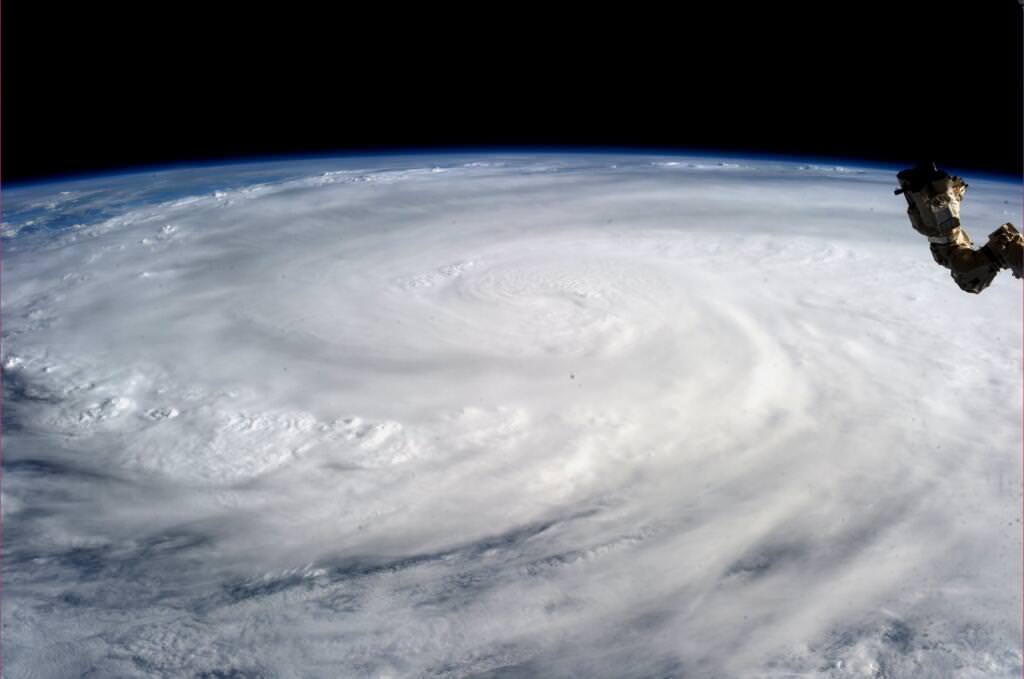
Super Typhoon Haiyan over the Philippines on November 9, 2013 as imaged from Earth orbit by NASA Astronaut Karen Nyberg aboard the International Space Station.Category 5 killer storm Haiyan stretches across the entire photo from about 250 miles (400 kilometer) altitude. Credit: NASA/Karen Nyberg
See more Super Typhoon Haiyan imagery and video below
[/caption]
NASA GODDARD SPACE FLIGHT CENTER, MARYLAND – Super Typhoon Haiyan smashed into the island nation of the Philippines, Friday, Nov. 8, with maximum sustained winds estimated at exceeding 195 MPH (315 kilometer per hour) by the U.S. Navy Joint Typhoon Warning Center – leaving an enormous region of catastrophic death and destruction in its terrible wake.
The Red Cross estimates over 1200 deaths so far. The final toll could be significantly higher. Local media reports today say bodies of men, women and children are now washing on shore.
The enormous scale of Super Typhoon Haiyan can be vividly seen in space imagery captured by NASA, ISRO and Russian satellites – as well as astronaut Karen Nyberg flying overhead on board the International Space Station (ISS); collected here.
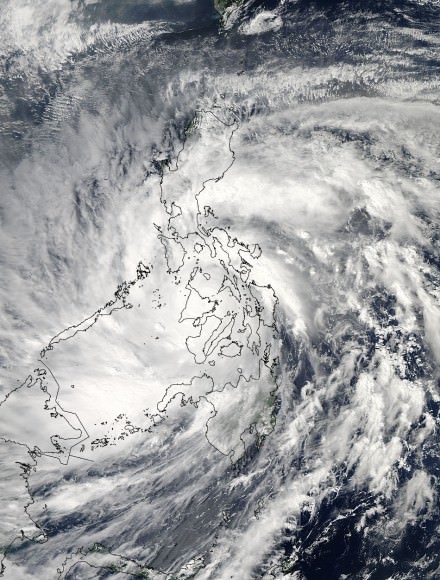
Super Typhoon Haiyan is reported to be the largest and most powerful storm ever to make landfall in recorded human history.
Haiyan is classified as a Category 5 monster storm on the U.S. Saffir-Simpson scale.
It struck the central Philippines municipality of Guiuan at the southern tip of the province of Eastern Samar early Friday morning Nov. 8 at 20:45 UTC (4:45 am local time).
As Haiyan hit the central Philippines, NASA says wind gusts exceeded 235 mph (379 kilometers per hour).
The high resolution imagery and precise measurements provided by the worlds constellation of Earth observing space satellites (including NASA, Roscosmos, ISRO, ESA, JAXA) are absolutely essential to tracking killer storms and providing significant advance warning to evacuate residents in affected areas to help minimize the death toll and damage.
More than 800,000 people were evacuated. The storm surge caused waves exceeding 30 feet (10 meters), mudslides and flash flooding.
NASA’s Tropical Rainfall Measuring Mission (TRMM) satellite captured visible, microwave and infrared data on the storm just as it was crossing the island of Leyte in the central Philippines, reports NASA – see image below.
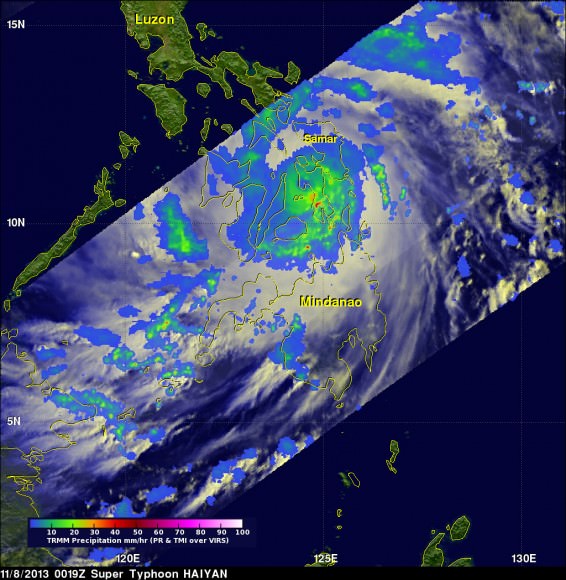
TRMM data from rain rates are measured by the TRMM Precipitation Radar (PR) and TRMM Microwave Imager (TMI) and combined with infrared (IR) data from the TRMM Visible Infrared Scanner (VIRS) by science teams working at NASA’s Goddard Space Flight Center in Greenbelt, Md.
Coincidentally NASA Goddard has just completed assembly of the next generation weather satellite Global Precipitation Measurement (GPM) observatory that replaces TRMM – and where I inspected the GPM satellite inside the Goddard clean room on Friday.
“GPM is a direct follow-up to NASA’s currently orbiting TRMM satellite,” Art Azarbarzin, GPM project manager, told Universe Today during my exclusive clean room inspection of the huge GPM satellite.
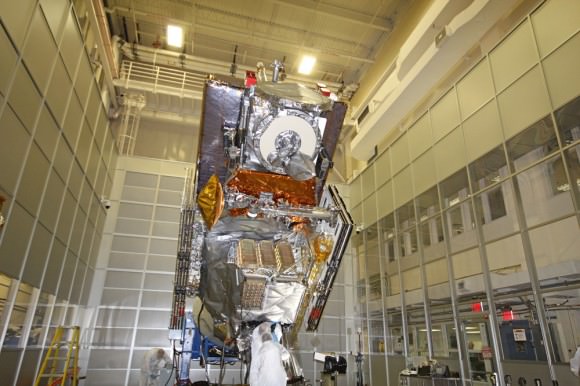
“TRMM is reaching the end of its usable lifetime. GPM launches in February 2014 and we hope it has some overlap with observations from TRMM.”
“The Global Precipitation Measurement (GPM) observatory will provide high resolution global measurements of rain and snow every 3 hours,” Dalia Kirschbaum, GPM research scientist, told me at Goddard.
GPM is equipped with advanced, higher resolution radar instruments. It is vital to continuing the TRMM measurements and will help provide improved forecasts and advance warning of extreme super storms like Hurricane Sandy and Super Typhoon Haiyan, Azarbarzin and Kirschbaum explained.
Video Caption: Super Typhoon Haiyan imaged on Nov 6 – 8, 2013 by the Russian Elektro-L satellite operating in geostationary orbit. Credit: Roscosmos via Vitaliy Egorov
The full magnitude of Haiyan’s destruction is just starting to be assessed as rescue teams reach the devastated areas where winds wantonly ripped apart homes, farms, factories, buildings and structures of every imaginable type vital to everyday human existence.
Typhoon Haiyan is moving westward and is expected to forcefully strike central Vietnam in a day or two. Mass evacuations are underway at this time
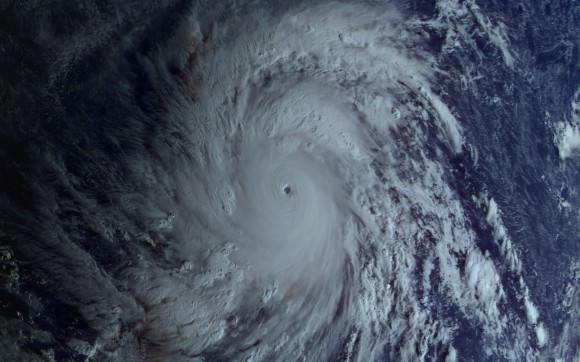
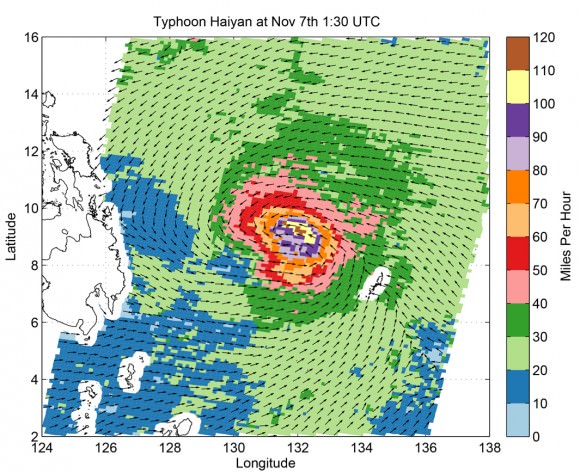
The Gravity field and steady-state Ocean Circulation Explorer (GOCE) satellite has been orbiting Earth in super-low orbits since 2009, mapping out variations in Earth’s gravity in extreme detail. But its fuel ran out in mid-October and the satellite began its slow descent towards Earth, being brought lower and lower by the effects of the atmosphere. Engineers predict it will re-enter completely and fall back to Earth sometime this weekend.
But no one can say for sure when or where the 1-ton satellite will fall.
With no remaining fuel to guide its re-entry there’s no way to nudge or steer its descent. And while most of GOCE is predicted to disintegrate in the atmosphere, several parts might reach Earth’s surface. Experts predict as much as 25% of the spacecraft will survive reentry, as many parts are made of advanced materials, such as carbon-carbon composites.
Today, engineers from the GOCE mission said that the spacecraft is predicted to enter into Earth’s atmosphere sometime during the night between Sunday and Monday, November 10-11, 2013. Break-up of the spacecraft will occur at an altitude of approximately 80 km. “At the moment, the exact time and location of where the fragments will land cannot be foreseen,” says ESA.
The GOCE spacecraft was designed to fly low and has spent most of its mission roughly 500 km below most other Earth-observing missions, at an altitude of 255 km (158 miles), but has recently been at the lowest altitude of any research satellite at 224 km (139 miles).
Its durable construction and sleek design allowed it to stay in space for longer than expected; it nearly tripled its planned lifetime.
With GOCE data, scientists created the first global high-resolution map of the boundary between Earth’s crust and mantle – called the Moho – and to detect sound waves from the massive earthquake that hit Japan on 11 March 2011, among other results.
Heiner Klinkrad, Head of ESA’s Space Debris Office at ESOC, Darmstadt, Germany said that when the spacecraft reaches altitudes below 100 km, then atmospheric density will drastically increase on the spacecraft. It will enter at about 25,000 km/hour, and aerodynamic pressure and heating will cause a break-up of the spacecraft at approximately 80km altitude, causing a large number of fragments.
“The risk to the population on ground will be minute,” said Klinkrad. “Statistically speaking, it is 250,000 times more probable to win the jackpot in the German Lotto than to get hit by a GOCE fragment. In 56 years of space flight, no man-made space objects that have re-entered into Earth’s atmosphere have ever caused injury to humans.”
An international campaign will be monitoring the descent, involving the Inter-Agency Space Debris Coordination Committee. The situation is being continuously watched by ESA’s Space Debris Office, which will issue re-entry predictions and risk assessments.
ESA says they will keep the relevant safety authorities permanently updated.
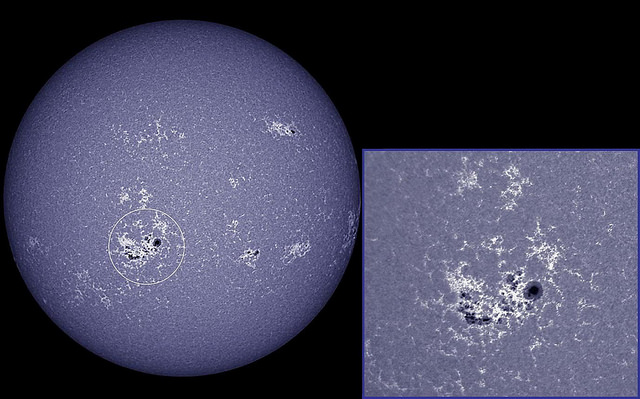
The Sun is finally acting like it’s in solar maximum. Our Sun has emitted dozens of solar flares in since Oct. 23, 2013, with at least six big X-class flares. Just today it blasted out a X1.1 flare at 04:32 UT (11:32 p.m. EST on Nov. 7, 2013). While old Sol had been fairly quiet for the time where it was supposed to be active in its normal 11-year cycle, only recently has activity ramped up with increased flares and sunspots. During 2013, there has been intermittent strong activity (like this and this in May), but the activity since mid-October is really the first extended period of activity.
Speaking of sunspots, a huge group called designated as AR 1890 has turned to face Earth. Thanks to astrophotographer Ron Cottrell for capturing the group today, above. Spaceweather.com reports that this sunspot has a trend of producing very brief flares. The X1-flare today was no exception as it lasted barely a minute. NOAA is forecasting a 60% chance of M-class solar flares and a 20% chance of X-flares on Nov. 8th from this sunspot group.
You can see an image from the Solar Dynamics Observatory below, as it recorded a flash of extreme UV radiation from the blast site:
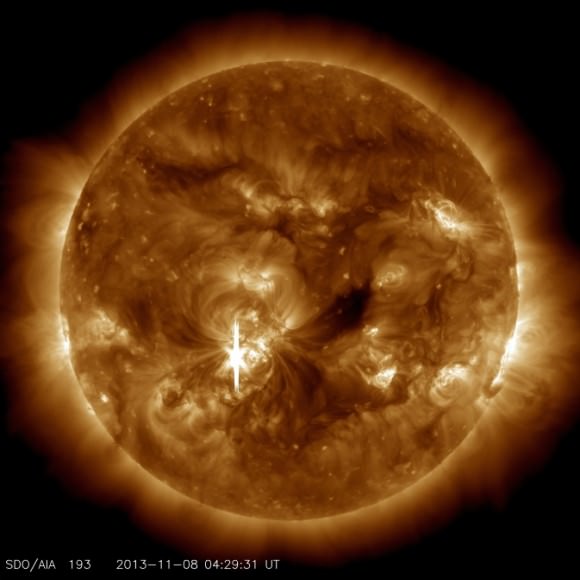
NASA describes a solar flare as such:
A flare is defined as a sudden, rapid, and intense variation in brightness. A solar flare occurs when magnetic energy that has built up in the solar atmosphere is suddenly released. Radiation is emitted across virtually the entire electromagnetic spectrum, from radio waves at the long wavelength end, through optical emission to x-rays and gamma rays at the short wavelength end. The amount of energy released is the equivalent of millions of 100-megaton hydrogen bombs exploding at the same time.
While solar flares are powerful bursts of radiation, harmful radiation from a flare cannot pass through Earth’s atmosphere to physically affect humans on the ground. But when they are intense enough, they can disturb the atmosphere in the layer where GPS and communications signals travel.
You can keep track of the Sun’s activity at NOAA’s Space Weather Prediction Center and the Solar Dynamics Observatory website.
Host: Fraser Cain
Guests: Thad Szabo, Scott Lewis, Ian O’Neill, Alan Boyle, Nancy Atkinson, David Dickinson, Jason Major, Matthew Francis, Nicole Gugliucci
LINKS:
(Check out the comments for some more excellent discussion!)
Alan Boyle on Virgin Galactic
Nancy Atkinson on the hybrid solar eclipse
Jason Major on baby supermassive black holes
Ian O’Neill on quasars (BLACK HOLES DON’T SUCK)
Alan Boyle on Chelyabinsk
Security cam of Chelyabinsk
Matthew Francis on LUX
Nancy Atkinson on the sun (not literally)
Scott Lewis on Frontier Fields
Matthew Francis on Earth-density exoplanet
David Dickinson on GOCE
Kepler Orrery
Fireball FAQs
Take a ride on the Mercury express and see what MESSENGER sees in these two new videos! Each made from over 280 Narrow-Angle Camera (NAC) images taken at intervals of four seconds, the videos give us a first-class seat on a flight over some of the rugged, sun-scorched surfaces on Mercury’s southern hemisphere.
Check out the second video below:
Continue reading “Fly Across Mercury with MESSENGER!”
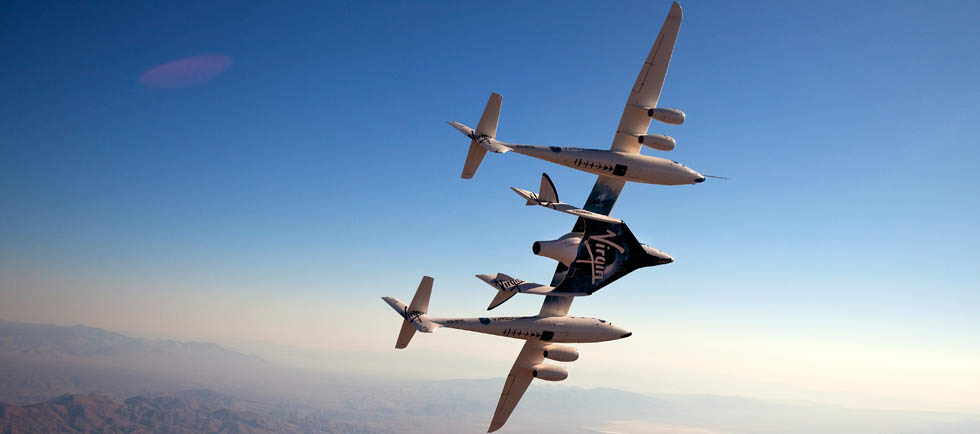
In true Richard Branson flair, the founder of Virgin Galactic has a multimedia plan in place for when he and his adult children, Holly and Sam, take the first planned tourist spaceflight next year. Virgin Galactic and NBCUniversal signed a “multi-platform partnership” for the network’s affiliates to transmit the flight all over the place.
Disclosed platforms so far include CNBC, MSNBC, NBCNews.com, Syfy and The Weather Channel. They also plan a “primetime special” on NBC on the launch’s eve, and to host a live event for three hours on NBC’s Today show. Financial terms were not released.
“Virgin Galactic is thrilled that NBCUniversal will join us on our exciting first journey to space,” stated Branson. “In this first chapter of commercial space travel, we will help make space accessible and inspire countless more people to join us in the pursuit of space exploration and science innovation.”
Virgin’s SpaceShipTwo is in the midst of powered flight tests and the company has hundreds of people signed up for flights. The company is one of several American contenders to run space tourism flights regularly, with XCOR Aerospace and Amazon founder Jeff Bezos’ Blue Origin among the most cited competitors.
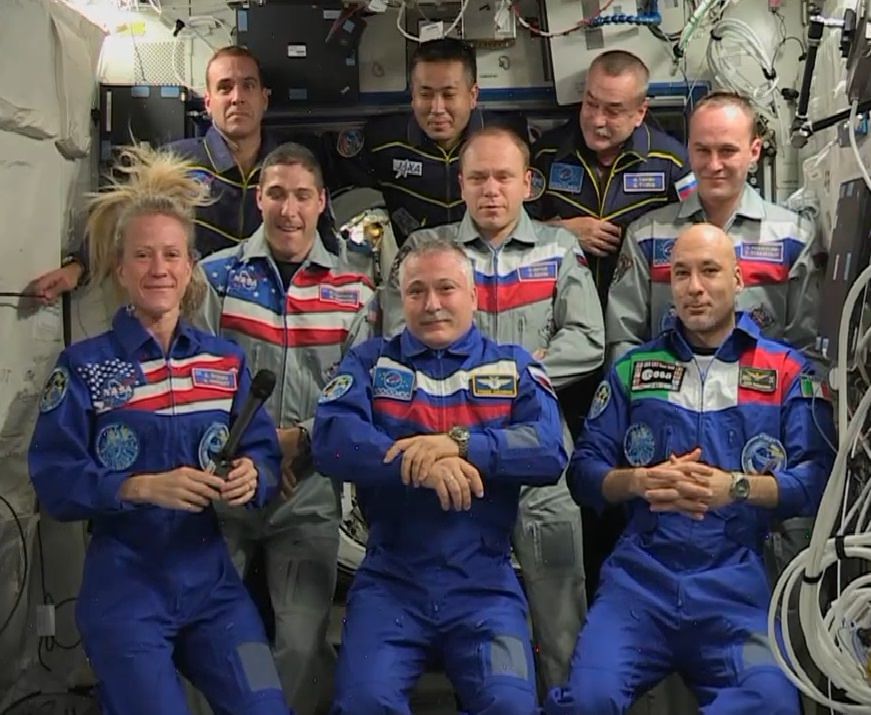
Things are a little more crowded than usual in the International Space Station. For a few days, nine astronauts and cosmonauts are floating in the cramped quarters of the orbiting complex. Typical crew sizes range between three and six. How did the astronauts find room to work and sleep?
“One of the things we had to do was make space for them,” said European Space Agency astronaut Luca Parmitano in a rare press conference today (Nov. 8) from orbit, which included participation from Universe Today. He then explained a procedure where the astronauts swapped a Soyuz crew spacecraft from one Russian docking port to another a few days before Expedition 38/39’s crew arrived on board on Thursday. This cleared the way for three more people to arrive.
“We [also] had to adjust for emergency procedures. All of our procedures are trained and worked for a group of six. We had to work on a way to respond if something happened.” As for sleeping, it was decided the six people already on board, “as seniority, would stay in the crew quarters.” The newer astronauts have temporary sleeping arrangements in other modules until the ranks thin out a bit on Sunday.
So this works for a short while, but what about the long-term? Could the station handle having nine people there for weeks at a time, rather than six, and would there be enough science work to go around?
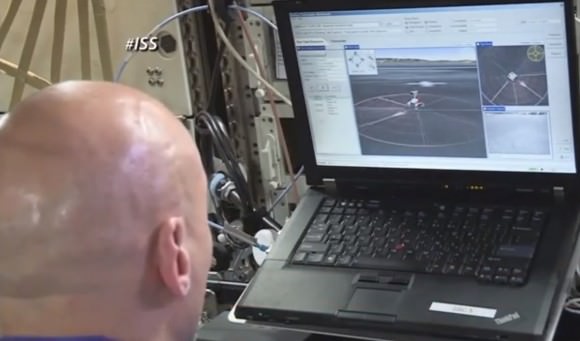
“I think, absolutely, moving to nine people is doable and in terms of the science would be fantastic,” NASA astronaut Karen Nyberg said. The station partners had experience with increasing crews before, she added, as for several years a regular space station rotation was only three astronauts during construction. Bumping up to the current maximum of six was a “big jump.”
“One of the things to be concerned about our environmental control system, our CO2 [carbon dioxide scrubbing] system … and also the consumables and the supplies we need,” she added. “Making up the science for us to do would be very doable. I think the hard part would be getting the systems to accommodate nine people.”
Parmitano, Nyberg and Russian cosmonaut Fyodor Yurchikhin plan to return to Earth Sunday, but a busy weekend lies ahead. On Saturday, Roscosmos (Russian Federal Space Agency) flight engineers Oleg Kotov and Sergey Ryazanskiy of the Russian Federal Space Agency will start a spacewalk around 9:30 a.m. EST (2:30 p.m. UTC) if all goes to plan.
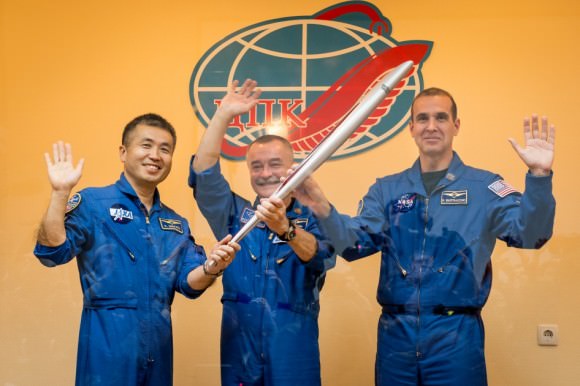
As part of the Olympic torch relay ahead of the Sochi games in 2014, they will briefly bring the Olympic torch outside with them, unlit, before doing some outside maintenance.
“After the photo opportunity, Kotov and Ryazanskiy will prepare a pointing platform on the hull of the station’s Zvezda service module for the installation of a high resolution camera system in December, relocate … a foot restraint for use on future spacewalks and deactivate an experiment package,” NASA stated in a Thursday press release.
Several journalists were unable to ask questions during the NASA portion of the press conference, which included participation from countries covered by NASA, the European Space Agency, the Japanese Aerospace Exploration Agency and Roscosmos (the Russian Federal Space Agency).
“We had a failure in a crucial component in the phone bridge,” NASA spokesman Kelly Humphries told Universe Today following the media event. They don’t know what component failed, but most of the journalists were unable to hear the moderator or the astronauts.
“A piece of equipment picked the wrong time to fail,” Humphries said
NASA will do a thorough investigation before holding another event like this to make sure it works for everyone.
Here’s a replay of the news conference:
Of course you do! (Who doesn’t?) And so here’s a wonderful tour of our Solar System to provide you with just the type of space you need.
A 3D animation project by Australian video artist Shane Gehlert, I Need Some Space takes us from low-Earth orbit to the Moon and Sun and then through the lineup of planets in the Solar System, using images and models from NASA to accurately depict their unique appearances. Along the way we’ll get some basic info on the planets, select moons, and a few of the various spacecraft that have visited (or are visiting) each world. Set to an intriguing string score by The Zephyr Quartet (of which Shane’s sister Belinda is a member) I Need Some Space is a mesmerizing 6-minute voyage for any space fan — myself very included.
I particularly like the “ghostly” look of Pluto, reminding us that we still have another year and a half before New Horizons reveals its true appearance to us.
Enjoy! (As with most videos, full-screening and HD-ing are strongly suggested.)
Video © Shane Gehlert/BlueDog Films. HT to FastCoCreate.
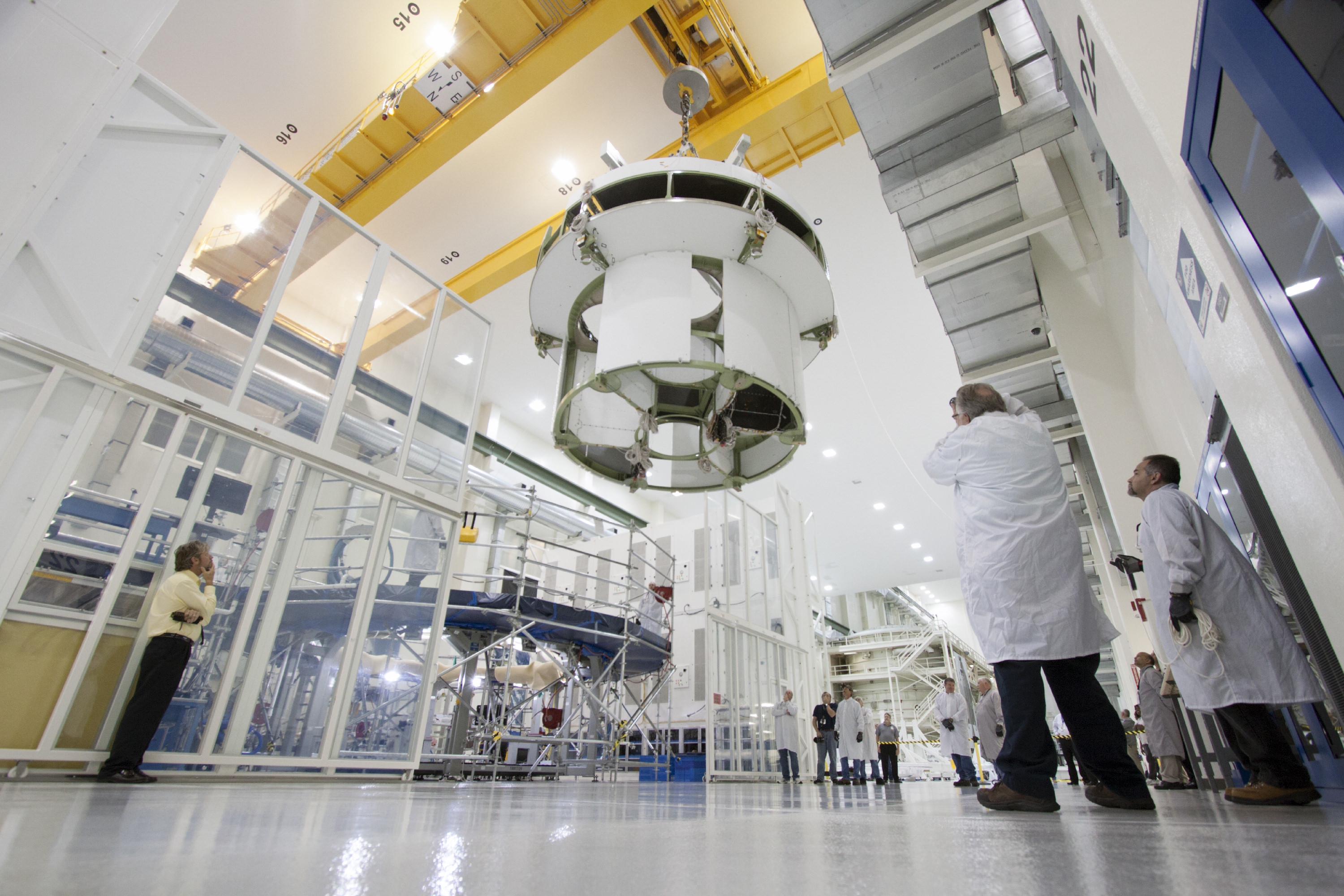
KENNEDY SPACE CENTER, FL – All of the key hardware elements being assembled for NASA’s new Orion spacecraft launching just under one year from now are nearing completion at the Kennedy Space Center (KSC) – at the same time as a crucial and successful hardware test in California this week helps ensure that the Exploration Flight Test-1 (EFT-1) vehicle will be ready for an on-time liftoff.
Orion is NASA’s first spaceship designed to carry human crews on long duration flights to deep space destinations beyond low Earth orbit, such as asteroids, the moon, Mars and beyond.
In a major construction milestone, Orion’s massive Service Module (SM) was hoisted out from the tooling stand where it was manufactured at the Operations and Checkout Building (O & C) at KSC and moved to the next assembly station where it will soon be mated to the spacecraft adapter cone.
The SM should be mated to the crew module (CM) by year’s end, Orion managers told Universe Today during my recent inspection tour of significant Orion hardware at KSC.
“We are working 24 hours a day, 7 days a week,” said Jules Schneider, Orion Project manager for Lockheed Martin at KSC, during an exclusive interview with Universe Today inside the Orion clean room at KSC. “We are moving fast!”
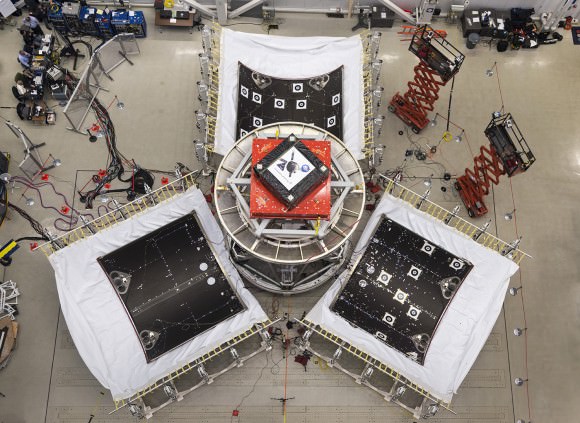
The Orion CM recently passed a significant milestone when it was “powered on” for the first time at KSC.
“We are bringing Orion to life. Lots of flight hardware has now been installed.”
And on the other side of the country, the Service Module design passed a key hurdle on Wednesday (Nov. 6) when the trio of large spacecraft panels that surround the SM were successfully jettisoned from the spacecraft during a systems test by Lockheed Martin that simulates what would happen during an actual flight several minutes after liftoff.
“Hardware separation events like this are absolutely critical to the mission and some of the more complicated things we do,” said Mark Geyer, Orion program manager at NASA’s Johnson Space Center in Houston. “We want to know we’ve got the design exactly right and that it can be counted on in space before we ever launch.”

Lockheed Martin is the prime contractor for Orion and responsible for assembly, testing and delivery of the Orion EFT-1 spacecraft to NASA that’s slated for an unmanned test flight targeted to lift off from Cape Canaveral, Florida in September 2014.
The CM rests atop the SM similar to the Apollo Moon landing program architecture.
However in a significant difference from Apollo, the Orion fairings support half the weight of the crew module and the launch abort system during launch and ascent. The purpose is to improve performance by saving weight thus maximizing the vehicles size and capability.
The SM also provides in-space power, propulsion capability, attitude control, thermal control, water and air for the astronauts.
At Lockheed Martin’s Sunnyvale, California facility a team of engineers used a series of precisely-timed, explosive charges and mechanisms attached to the Orion’s protective fairing panels in a flight-like test to verify that the spacecraft can successfully and confidently jettison them as required during the ascent to orbit.
The trio of fairing panels protect the SM radiators and solar arrays from heat, wind and acoustics during ascent.
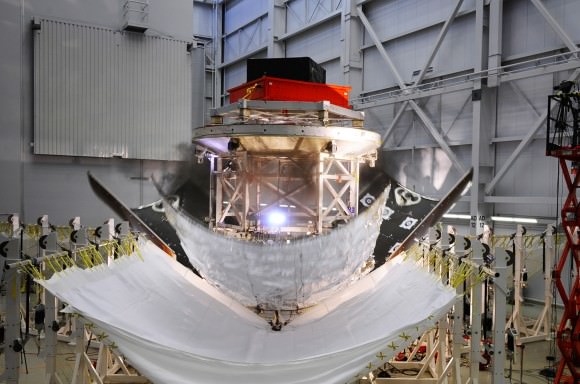
“This successful test provides the Orion team with the needed data to certify this new fairing design for Exploration Flight Test-1 (EFT-1) next year. The test also provides significant risk reduction for the fairing separation on future Orion manned missions,” said Lance Lininger, engineering lead for Lockheed Martin’s Orion mechanism systems in a statement.
This was the 2nd test of the fairing jettison system. During the first test in June, one of the three fairing panels did not completely detach due to an interference “when the top edge of the fairing came into contact with the adapter ring and kept it from rotating away and releasing from the spacecraft,” said NASA.
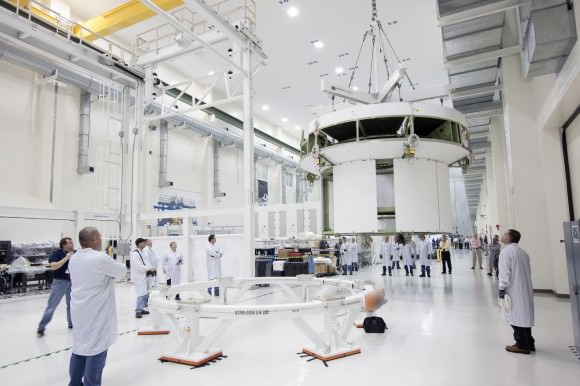
2013 has been an extremely busy and productive year for the Orion EFT-1 team.
“There are many significant Orion assembly events ongoing this year,” said Larry Price, Orion deputy program manager at Lockheed Martin, in an interview with Universe Today at Lockheed Space Systems in Denver.
“This includes the heat shield construction and attachment, power on, installing the plumbing for the environmental and reaction control system, completely outfitting the crew module, attached the tiles, building the service module and finally mating the crew and service modules (CM & SM),” Price told me.
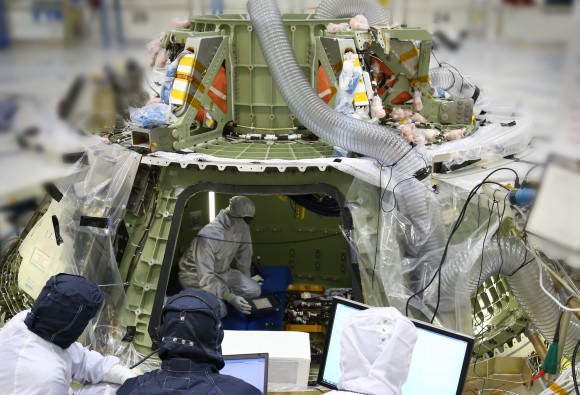
The two-orbit, four- hour flight will lift the Orion spacecraft and its attached second stage to an orbital altitude of 3,600 miles, about 15 times higher than the International Space Station (ISS) – and farther than any human spacecraft has journeyed in 40 years.